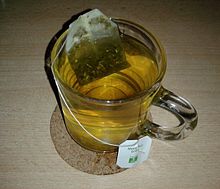South American beverage From Wikipedia, the free encyclopedia
Mate cocido[2] (Spanish pronunciation: [ˈmate koˈsiðo], 'boiled maté', or just cocido in Corrientes Province), chá mate (Brazilian Portuguese: [ˈʃa ˈmatʃi], 'maté tea'), kojoi (Guarani pronunciation: [koˈɟoi]), or yerbiado (Cuyo, Argentina) is an infusion typical of Southern Cone cuisine (mostly consumed in Southern Brazil, the Bolivian Chaco, Paraguay, Argentina and Uruguay). It is traditionally prepared by boiling yerba-maté in water, then strained and served in cups. It is a bitter tasting beverage, similar to maté but milder, with the same stimulating and nutritional properties. It is also sold in teabags, so it can be prepared like tea.
 | |
| Type | Hot or cold beverage |
|---|---|
| Introduced | 17th century[1] |

The Jesuits in the current territories of the south of Brazil and Paraguay, and the Argentine provinces of Misiones and Corrientes, in the first decades of the 17th century improved the cultivation technique of yerba-maté and exported it. Spain, to compete with the tea that England sold, put a chopped yerba-maté on sale to make tea that became popular in Europe, known as the "Tea of the Jesuits".[1]
That "Tea of the Jesuits" from the 17th century, today has become the mate cocido, a very popular infusion that, because of the low price of yerba-maté compared to the price of tea or coffee, has become since the early 20th century the common beverage in schools, hospitals and prisons.[1]
The preparation of mate cocido in tea bags is almost the same as regular yerba-maté, with the difference that in grinding the dust and sticks are removed, sorting and processing only the leaves.[3] Mate cocido is also produced in soluble form.[4]
Seamless Wikipedia browsing. On steroids.